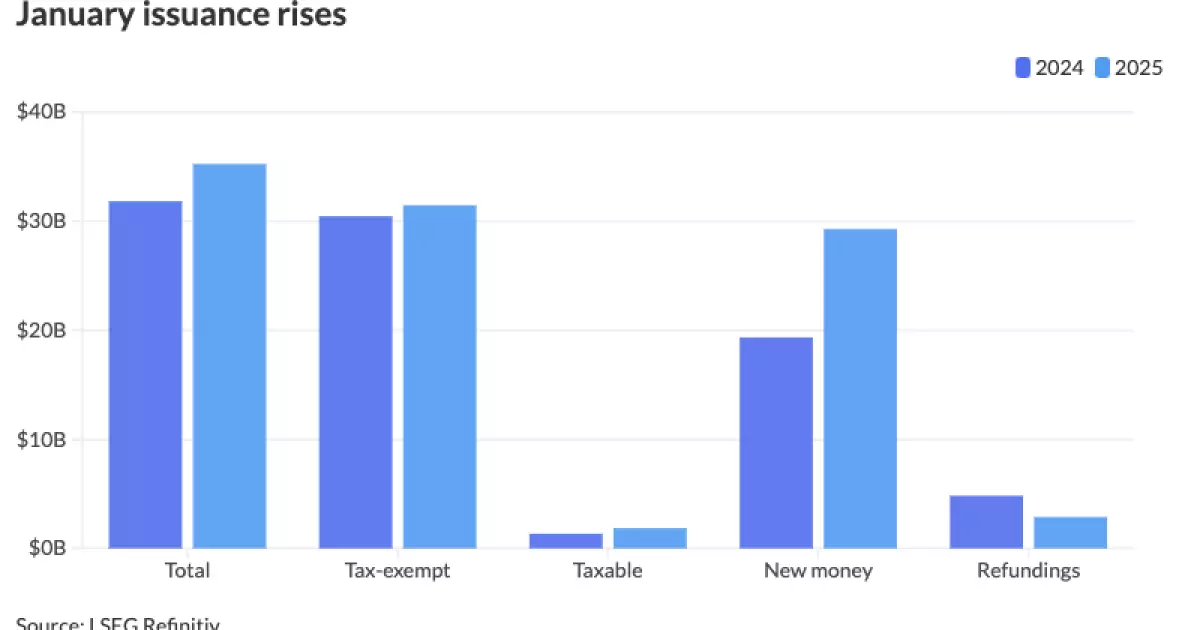The municipal bond market is a vital indicator of fiscal health and investor confidence within the broader economy. January 2025 proved to be a significant month for municipal bond issuance, showing substantial growth compared to the same month in the previous year. This analysis delves into the trends and underlying factors behind this surge in issuance, juxtaposed against the backdrop of economic uncertainty and evolving fiscal policies.
Data from LSEG reveals that municipal bond issuance in January reached a staggering $35.243 billion across 486 offerings, representing a 10.8% increase from $31.817 billion in 554 deals recorded in January 2024. Additionally, January’s figures exceeded the ten-year average of $28.675 billion for the month, indicating a robust demand for municipal bonds. This uptick points towards a strategic maneuver by issuers eager to capitalize on current market conditions and secure financing before anticipated volatility stemming from changing legislative and regulatory landscapes.
Analysts suggest that part of this rise can be attributed to the political climate and uncertainty regarding future fiscal policies. The ongoing discussions surrounding interest rates and the potential for tax changes have compelled issuers to act decisively. According to Alice Cheng, a credit analyst at Janney, many issuers are likely reacting to this climate of uncertainty by flooding the market with new issues, hoping to lock in advantageous conditions before potential rate cuts or regulatory shifts take effect.
Significant attention has been drawn to the recent Federal Open Market Committee (FOMC) meeting, where the Federal Reserve maintained interest rates within a range of 4.25% to 4.50%. Despite this, President Donald Trump’s pressure to consider rate cuts has left issuers in a state of anxious anticipation. These dynamics have created an environment of heightened awareness surrounding interest rates, ultimately contributing to the rush of issuers entering the market.
Moreover, the concern regarding the potential clawback of funds from the Infrastructure Investment and Jobs Act has further stoked fears among issuers, prompting them to act with urgency. Issuers may have concluded that it is preferable to secure funding now rather than face uncertainties in the future.
As the market emerges from a period characterized by volatility, experts point to a backlog of capital projects that had previously been delayed or sidelined. James Pruskowski, Chief Investment Officer at 16Rock Asset Management, notes that many issuers postponed their transactions to January in anticipation of more favorable market conditions. This scenario has contributed to an influx of new-money issuance, up 51.4% to $29.268 billion from $19.337 billion in the same period last year.
The demand for funding has transitioned aggressively from a stagnant state to heightened activity, as the expiration of COVID-era federal aid has left many projects unfunded. Increasing pressure on local and state governments to initiate spending has driven the urgency behind new bond offerings, indicating a broader resurgence of activity in municipal finance.
Across various states, California emerged as the leader, accounting for a remarkable $6.371 billion in issuances, up 12.6% year-over-year. Texas, Florida, New York, and Massachusetts also contributed significantly to overall issuance totals. Florida’s impressive 115.1% increase stands out as a remarkable contrast to Massachusetts, which experienced a staggering decline of 50.2%. This dichotomy highlights the varied circumstances impacting individual states and their respective bond markets.
The rise in taxable issuance by 36.7% to $1.849 billion compared to the previous year embodies another significant trend, as investors diversify their portfolios to seek better yields amidst a fluctuating environment. The report also highlighted a significant decrease in refundings, indicating a shift in the market’s focus toward financing new projects rather than refinancing existing debts.
The analysis of January’s municipal bond issuance underscores a market responding to a mixture of urgency, demand, and strategic foresight. The current market conditions seem primed for continued growth, characterized by strong issuance figures and an increasing number of projects looking for funding. Despite the prevailing uncertainties, analysts remain optimistic, projecting a solid volume of supply throughout 2025. This anticipated activity not only points to a robust bond market but underscores the vital role municipal bonds play in the broader economic landscape, especially as governments harness municipal financing to bolster infrastructure, development, and economic stability.

